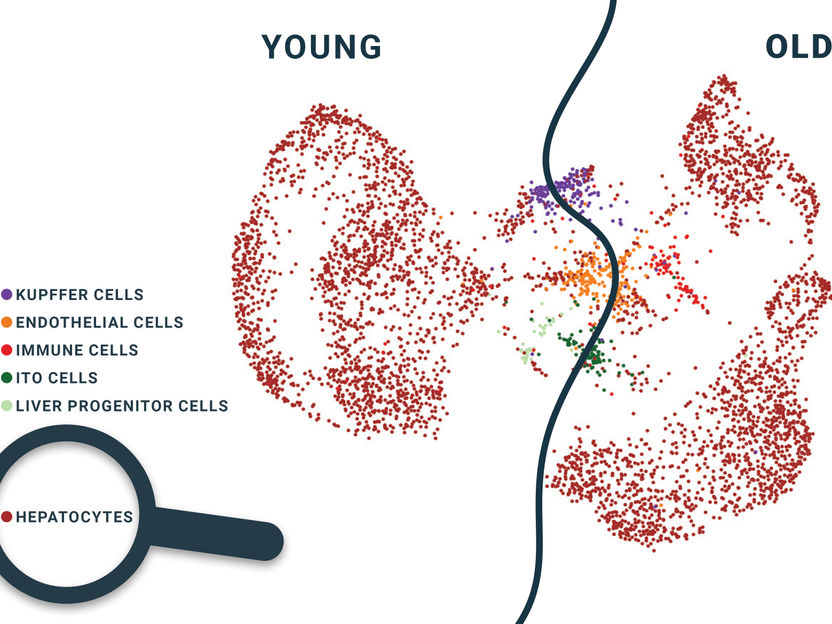Location, location, location - Liver cells age differently depending on where they are in the organ
Looking around us, we can see that people age at different rates. But what about inside? Do all cells age in the same way? And does the location of a cell in the organ make a difference to the ageing process? Researchers at the Max Planck Institute for Biology of Ageing in Cologne and CECAD Excellence Cluster for Ageing Research have now shown in the liver of mice that liver cells age differently depending on where they are located in the organ.

The epigenome of hepatocytes changes with increasing age. The figure shows a graphical representation of epigenetic measurement data. The further apart two points are, the more different is the epigenome of the cells.
Peter Tessarz, Katharina Link / Max-Planck-Institut für Biologie des Alterns
The location of the liver cells has a strong influence on the ageing process. In the region of the liver where the liver cells use oxygen for energy production in their mitochondria, this process deteriorates significantly with age. In the central, oxygen-deprived area of the liver, however, the researchers found no change in the mitochondria, but a change in the cells' fat metabolism.
"It is important where a cell ages. They age differently depending on where they are located and what their function is," says Peter Tessarz, research group leader at the Max Planck Institute for Biology of Ageing and leader of the study. "For ageing research, this means that we have to pay close attention to which cells we are studying and where they are located in the organ.
Same cell type - different roles
The liver is largely made up of a single type of cell, the hepatocyte. Depending on where they are in the liver, they have different roles. Near the portal vein, where fresh, oxygen-rich blood enters the liver, hepatocytes use the oxygen to process fats in their mitochondria and produce energy. In contrast, carbohydrates are broken down in the less oxygen-rich regions of the liver.
"In the liver, the position of the hepatocyte in the organ plays a crucial role. That's why the liver was the perfect model for us to investigate whether location also makes a difference in ageing," explains Peter Tessarz.
The researchers analysed liver cells from young and old mice using cutting-edge technology that allowed them not only to obtain data for almost every single cell, but also to assign it to a position in the organ. They were particularly interested in which genes were still being read in old age, how the metabolism of the cells changed and whether epigenetic changes occurred.
According to Achim Tresch, Head of the Institute for Medical Statistics and Bioinformatics at CECAD and co-author of the study, the work shows "that the bioinformatic combination of different types of data at the single-cell level provides new insights into metabolic processes".
The study was conducted at the Max Planck Institute for Biology of Ageing and supported by the CECAD Cluster of Excellence for Ageing Research at the University of Cologne.
Original publication
Chrysa Nikopoulou, Niklas Kleinenkuhnen, Swati Parekh, Tonantzi Sandoval, Christoph Ziegenhain, Farina Schneider, Patrick Giavalisco, Kat-Folz Donahue, Anna Juliane Vesting, Marcel Kirchner, Mihaela Bozukova, Christian Vossen, Janine Altmüller, Thomas Wunderlich, Rickard Sandberg, Vangelis Kondylis, Achim Tresch, Peter Tessarz; "Spatial and single-cell profiling of the metabolome, transcriptome and epigenome of the aging mouse liver"; Nature Aging, 2023-11-9
Most read news
Original publication
Chrysa Nikopoulou, Niklas Kleinenkuhnen, Swati Parekh, Tonantzi Sandoval, Christoph Ziegenhain, Farina Schneider, Patrick Giavalisco, Kat-Folz Donahue, Anna Juliane Vesting, Marcel Kirchner, Mihaela Bozukova, Christian Vossen, Janine Altmüller, Thomas Wunderlich, Rickard Sandberg, Vangelis Kondylis, Achim Tresch, Peter Tessarz; "Spatial and single-cell profiling of the metabolome, transcriptome and epigenome of the aging mouse liver"; Nature Aging, 2023-11-9
Organizations
Other news from the department science

Get the life science industry in your inbox
By submitting this form you agree that LUMITOS AG will send you the newsletter(s) selected above by email. Your data will not be passed on to third parties. Your data will be stored and processed in accordance with our data protection regulations. LUMITOS may contact you by email for the purpose of advertising or market and opinion surveys. You can revoke your consent at any time without giving reasons to LUMITOS AG, Ernst-Augustin-Str. 2, 12489 Berlin, Germany or by e-mail at revoke@lumitos.com with effect for the future. In addition, each email contains a link to unsubscribe from the corresponding newsletter.






















































